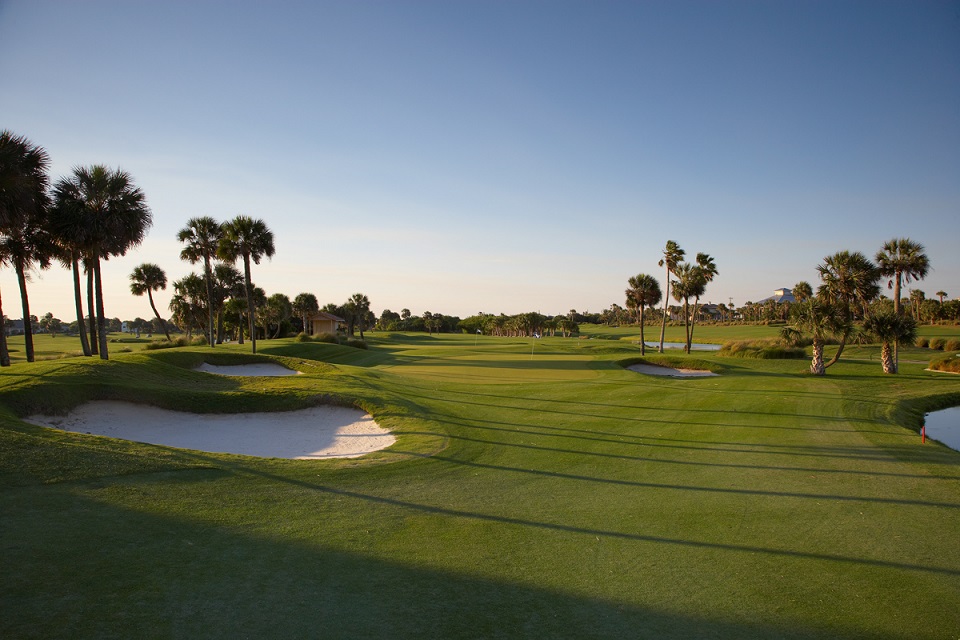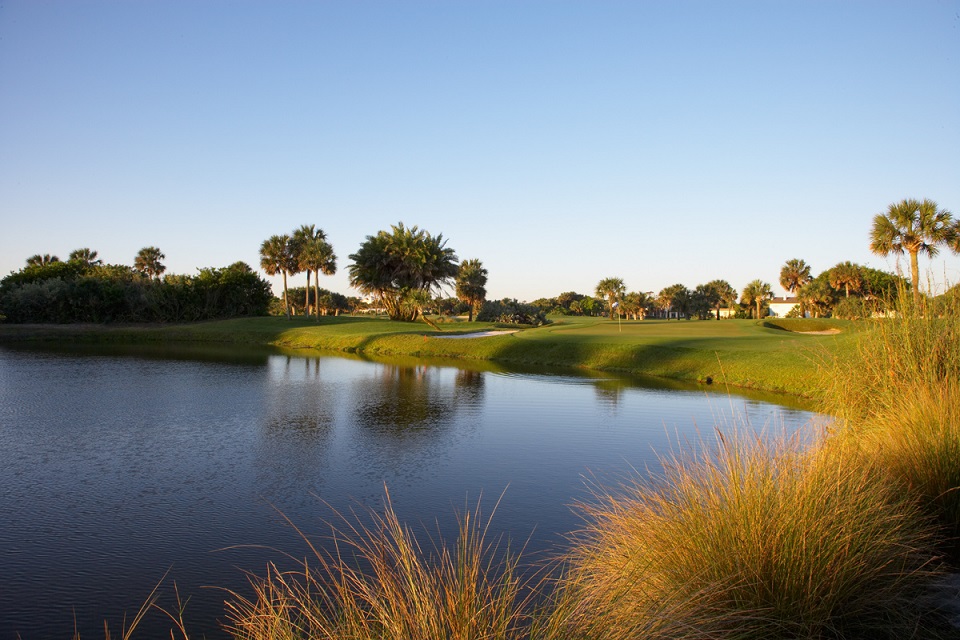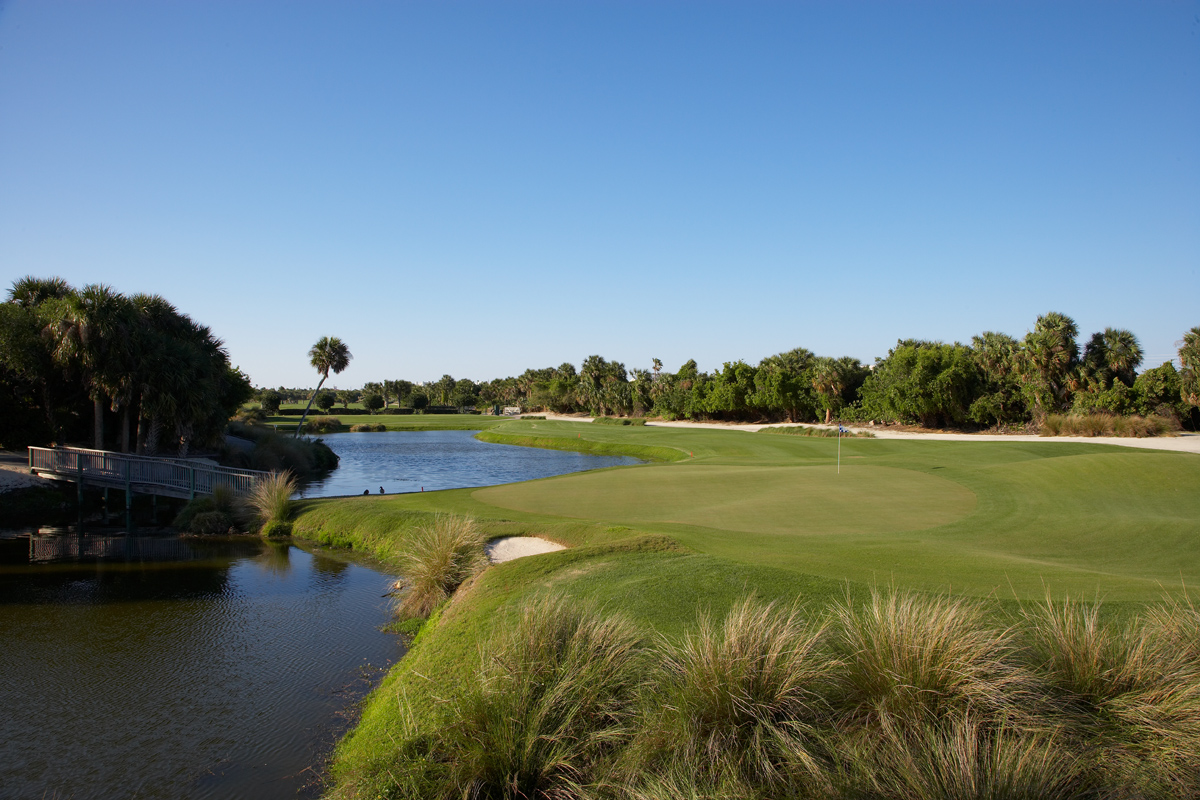
OCC History
The first club house stood near the freight depot on the mainland. The golf course was nearby. Some historical references indicate it to have been a 7-hole course, but most refer to it as a 9-hole course.
The course was built as an added attraction for winter guests and visitors to the then fabulous winter resort caravansary known as the Ormond Hotel, which was later to become the largest wooden structure in the world with 400 rooms and eleven miles of hallways, porches and breeze ways.
The hotel was first conceived by two extraordinary entrepreneurs, J. D. Price and John Anderson, who were to devote most of their remaining years to the development and management of this property, including that on which the Oceanside Country Club golf course exists today.
So conscious were they of the desirability of the area's location that they envisioned the need for a hotel property. Lacking funds to build one, they heard of a winter visitor who had come down sickly and returned North in good health. Better still, he was a wealthy man, Stephen VanCullen "Deacon" White, a New York Wall Street magnate.
Price and Anderson went up to see him and he not only fell in with their plans, but proposed building a railroad as well as a bridge across the Halifax. The nearest railroad was East Palatka. So he built his narrow gauge railroad, the St. John's and Halifax Railroad from there to Ormond. The hotel was completed and celebrated its opening January 1, 1888, with great ceremonies.


Concurrent with this activity Henry M. Flagler, one of John D. Rockefeller's first two partners in his oil wagon delivery business in Cleveland, that later became the Standard Oil Company, proceeded to use some of his oil company millions to build a railroad down the East Coast of Florida.
To provide destinations for his rail he conceived the idea of building resort hotels along his rail route and started with the Ponce de Leon in St. Augustine . It was completed in 1887.
Flagler saw the Ormond Hotel which opened the following year as a rival of his chain or an opportunity to fulfill his plan.
By then, White, the Wall Street magnate, could not obtain sufficient investment gains in the amount he desired and when Henry Flagler made him an offer, he accepted it.
The hotel's first golf course was a 9-hole affair across the Halifax River . It was there in 1904 that Harry Williams, the long-time course superintendent and golf pro in the Daytona area, arrived. To reach the course from the hotel, one first had to be ferried over. Later there was walking space on the wooden bridge and eventually mule-drawn cars were used.
The 9-hole course was supplanted in 1907 when Harry Williams and George Merritt were assigned to build a new course between the hotel and the ocean. It was designed by P. F. Seabloom, a landscaper who had designed the landscaping for Flagler's posh mansion in Palm Beach , " Whitehall ", and also designed the Country Club of Palm Beach course for the Breakers Hotel and the Ponce de Leon course in St. Augustine .
In building the new course, Williams had to go to Baltimore to hire a trainload of laborers. The fare to bring them down was $278.00 for the trainload. Swinging grub hoes and axes, they tore out the rough palmettos and trainloads of Bermuda grass were brought in and planted by hand. The first nine holes were completed in 1907 and the second nine the following year. To hasten the course's preparation and have it in readiness for the upcoming winter season, laborers worked at night watering the fairways. There was no sprinkling system at that time, at least not automatic. That did not come for many years.
The course had square sand greens which were not as bad as one would imagine. They had a marl base and red sand top. They were soft, says Williams, almost as soft as grass.
The new 18 hole course became known as the Ormond Beach Golf Links since, for most of its length except for dunes and the second clubhouse, it was properly adjoining the sea.
One of the Ormond Hotel's early century visitors was Henry Flagler's partner, John D. Rockefeller. In 1914, Rockefeller, then known as the "world's richest man", and his entourage of forty, rented the entire West Wing consisting of twenty rooms, and here he lived for three winters until he bought the Reverend Huntington's home across Granada Avenue (now Boulevard) and named it the "Casements."
Rockefeller's presence provided the Ormond area with world-wide publicity, frequently enriched by photos of him passing out his famous dime tips. In the latter years he even gave them to celebrities with whom he chatted following an afternoon of golf. One who turned the tables on him was Will Rogers who some press agent arranged to have the pair pictured with Will Rogers presenting JDR with a dime.
One of his greatest dedications was his love for the game of golf which he played even in his 90s. When one saw a crowd on the course, one could be sure it was a retinue of acquaintances and others who were following him around the course. Usually beside him was a little caddy boy to hold his oversized umbrella to shield him from the sun and rain.
His many Ormond guests included such notables as Harvey Firestone, President Harding, the Prince of Wales and among those who joined him in post-game chats were Marion Tally and Galli-Curci.
On another occasion, in 1923, a group of prominent Americans were guests aboard Mr. Ned McLean's yacht. McLean was the multi-millionaire whose wife once owned the Hope Diamond. Among the guests were President Harding, Senator Freylinghausen of New Jersey , Senator Fred Hall of Miami, Albert D. Lasker, Judge John Barton Payne, Charles G. Dawes, Director of the Budget and later Vice-President under Coolidge.
In 1918 Flagler's Palm Beach Hotel, The Breakers, sponsored the Championship of Palm Beach Tournament, later renamed the Women's Championship of Florida. So successful did this tournament become that Ray McCarthy Public Relations Agency was hired by the F.E.C. Hotels Organization to stimulate interest among winter visitors by expanding the idea and introducing it in the Flagler Hotels in Ormond Beach and St. Augustine . The Florida East Coast Championship was the name given to the St. Augustine tournament and the Women's South Atlantic to the Ormond Beach meet.
The three tournaments were run a week apart starting in Palm Beach and moving up the coast to Ormond Beach and then St. Augustine . It might be said that these three were the Florida Winter Orange Blossom Circuit of the 20s, a fore-runner of today's four Orange Blossom Tournaments starting with Harder Hall in Sebring, the South Atlantic here, the Doherty Challenge Cup in Fort Lauderdale and the International Four-Ball in Hollywood .
The Breakers discontinued the Palm Beach event in 1936 and when the Ponce de Leon Hotel was sold to a select girls' school, the St. Augustine Championship was also discontinued.
Ormond Beach support and respect for the SALLY is indicated by the continued sponsorship from 1926 and even through several changes of ownership of the course starting in 1948 when the Daytona Beach Chamber of Commerce, backed by the Ormond Beach Golf Association, induced F.E.C. officials to keep the golf course open throughout the year. The OBGA agreed to pay $1,000.00 per month to offset maintenance expenditures.
In 1949, Robert Woodward, formerly of the Peabody Hotel, Memphis , purchased the Ormond Hotel and golf course from the F.E.C. Hotel System bringing his hotel management institute here, but discontinued the school in 1950. He sold the golf course in 1951 to Merrill Ellinor. Ellinor made extensive improvements in the golf layout and renamed the course Ellinor Village Country Club. Through each of these changes the new owners continued the South Atlantic Championship as a major winter attraction.
In 1962, Ellinor sold the golf club and property to the newly-formed Oceanside Country Club Corporation. It was timely in 1976 that the new clubhouse should represent, not only the fifty years of SALLY history, but the long step from one room one-storey clubhouse near the freight depot on the mainland where it all began.
Oceanside Golf and Country Club became a reality on May 1, 1963, when the purchase of land and facilities was completed. The purchase price was $971,235.00 and the strategic plan was to sell off various parcels of land to cover the purchase cost. 2,000 feet of land on Granada was appraised at $600,000.00 and the initial parcel was sold in 1964 for $60,000.00, 200 feet to accommodate a professional building. Club membership numbered 389 in May, 1964.
The first club party was a Luau in August, 1963. Vince Minnelli and his South Sea Islanders played for dancing. The Lester Lanin "high society" orchestra played at the October, 1963 club party.
Twenty electric carts were included in the original purchase (not all operating). Spare parts from 12 other unusable carts were utilized to keep the "fleet" operating. Twenty four new Paugh carts were promptly purchased at $600.00 each. Substantial work was done to the course and clubhouse to improve conditions, almost everything required repair or replacement.
During 1964 the new club sold 1,450 feet frontage on Granada for $445,000.00 and the golf course was redesigned during 1965 to accommodate the Granada land sale and to permit both the front and back nines to begin and end at the clubhouse.
1970 was a busy year at Oceanside . Golf course conditions were improved with the addition of labor-saving equipment and installation of additional irrigation systems. A significant improvement was the addition of four new tennis courts to accommodate the Oceanside growing membership. On January, 1971, the club had 637 members.
During 1975 our present clubhouse was constructed and in 1976 the club sold two tracts of land on Granada - 200 feet where Sun Bank is now located and 312 feet where Food Lion now operates. The $668,304.00 realized from the sale was used to retire an existing mortgage and the balance placed in a restricted fund. The new clubhouse marked a "new era" in Oceanside history.
Many things happened over a short period of time at Oceanside . Many members were involved, especially the "Hermit" Club men's group. The "Hermit" Club provided enthusiasm and guidance for many improvements over the years, including the "south" practice green we all enjoy today.
In the late 70s and early 80s the club began to experience serious problems with salt water intrusion in our existing wells; even new wells did not solve the problem. During 1980 we received information from the city of Ormond Beach that relief from salt water intrusion may be in our future when plans are finalized to use effluent water from the city. During this period some golf course lakes were deepened and additional wells added. It was not until 1991 when we began receiving effluent water from the city of Ormond Beach that the course began to change for the better.
Mother Nature dealt Oceanside two bad blows in 1983 - a tornado and a deep freeze; however, the rain was helpful and the course conditions improved. Many members contributed time and funds to repair the damages.
In 1987 and 1988 our present clubhouse was completely renovated providing outstanding facilities for our members, new ballroom area new dining room, new ladies' and men's locker rooms, new Mixed Grille, everything improved.
Our golf course was completely renovated in 1993, mainly to improve drainage. In order to secure fill to solve drainage problems all existing lakes were made larger and deeper with the removed dirt used to raise course playing areas to facilitate drainage.
It is interesting to note that the highest land areas at Oceanside are 17 feet above sea level and the lake levels are 8 feet above sea level. A great deal of designing was necessary to solve the many problems with 9 feet of "fall" over 80 acres to work with. A new computer control irrigation system, as well as new tees and greens, were also accomplished. A new longer driving range was completed as well as an improved practice area. An attractive berm was also created along A1A south of Neptune to create a separation between holes 2 and 3 and the ever-busy A1A.
The New Millennium finds Oceanside better than it has ever been. Membership continues to grow and the facilities are being continuously improved. We have recently expanded the Tennis Courts and refurbished the pool area in the Spring. In addition, there as been added emphasis on developing programs for the children and grandchildren of members.
The SALLY continues to field contestants from all over the world including a large European contingent. With some architectural changes in the Golf course, the SALLY Girls are treated to quite the challenge - but in the end the usual windy weather crops up to provide the biggest challenge of all. When all is said and done, the whole event is a wonderful success.
| OCEANSIDE GOLF AND COUNTRY CLUB PAST PRESIDENTS | |||
|---|---|---|---|
| Frederick W. Rugg II | 1963 | Joe Epton | 1995 |
| Isham Adams | 1964 | Dr. James White | 1996 |
| Edward 0. Hausburg | 1965 | Thomas Dargan | 1997 |
| John Turney | 1966 | Mark O. Blanford | 1998 |
| W. W.Swann | 1967 | Bill Turner | 1999 |
| Walter S. Furbee | 1968 | Peter Heebner | 2000 |
| Fred Claflin | 1969 | E. Buck Bunhund | 2001 |
| Thomas C. Simpson | 1970 | Bill Sacks | 2002 |
| Joseph H. Askren | 1971-72 | Jim Weite | 2003 |
| James Kulzer | 1973-74 | Dr. Joe LeCompte | 2004 |
| A. S. Barney Barnhart | 1975 | Joseph Lennartz | 2005 |
| E. M. Ted Porter | 1976 | Clair Simpson | 2006 |
| Nicholas Fortunato | 1977-78 | Roy Gailey | 2006-07 |
| P. William Logan | 1979-80 | Brian Lindahl | 2008 |
| Harry Shoonshan | 1981 | Keith Bulko | 2009 |
| Nicholas Fortunato | 1982-83 | William Loucks | 2010 |
| Robert Weber | 1984-85 | Anthony Schoder, Jr. | 2011-12 |
| Anthony C. Schoder, Jr. | 1986 | Denise Kennedy | 2013 |
| Ken Hamlin | 1987 | Kathy Arnold | 2014 |
| Kit Martin | 1988 | Muffi Chanfrau | 2015 |
| Arthur A. Simpson | 1989 | Chuck Grant | 2016 |
| Richard C. Brown | 1990 | William McMunn | 2017 |
| Lee Culler | 1991 | Frank Johnson | 2018-19 |
| Bryant Byrd | 1992 | Joe Mirante | 2020 |
| Jack M. Young | 1993-94 | ||


